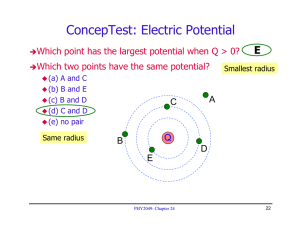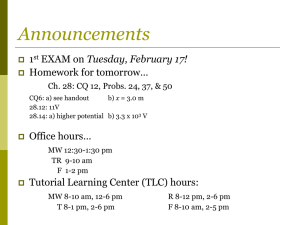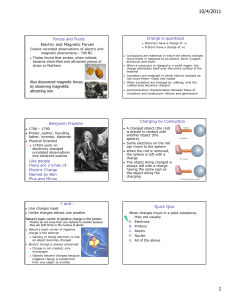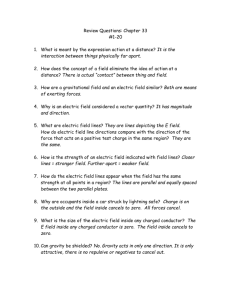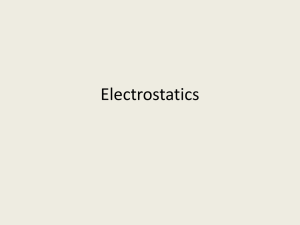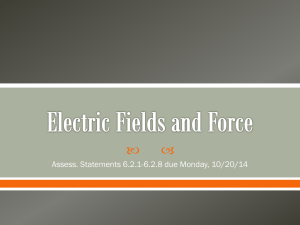ConcepTest: Electric Potential E Which two points have the same potential?
advertisement
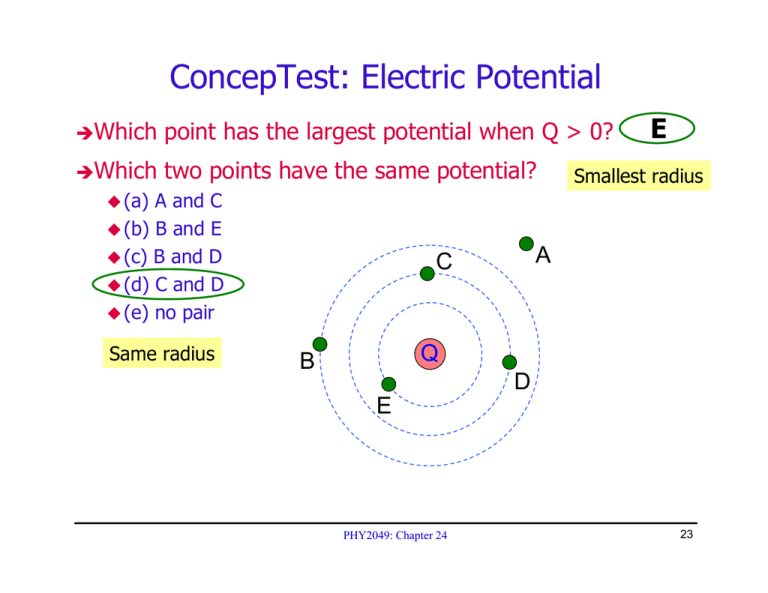
ConcepTest: Electric Potential ÎWhich point has the largest potential when Q > 0? ÎWhich two points have the same potential? A and C (b) B and E (c) B and D (d) C and D (e) no pair E Smallest radius (a) Same radius A C Q B D E PHY2049: Chapter 24 23 Multiple Charges: Superposition Î3 charges: Find total potential at a point in space +Q +Q11 − Q3 − Q3 r1 r3 +Q2 x r2 +Q2 Vtot −Q3 Q1 Q2 = V1 + V2 + V3 = k + k +k r1 r2 r3 V is a scalar ¾ No directions to worry about! ¾ But you do have to watch signs! PHY2049: Chapter 24 24 ConcepTest: Electric Potential ÎWhat is V at point A? (a) V>0 (b) V = 0 (c) V < 0 A B 60 cm Closer to + charge 40 cm 30 cm 26 cm Q2 = +50μC ÎWhat 26 cm Q1 = −50μC is V at point B? (a) V>0 (b) V = 0 (c) V < 0 Equal distance to both charges PHY2049: Chapter 24 25 ConcepTest: Electric Potential ÎAt which point does V = 0? (a) (b) (c) (d) (e) C A D B all of the above All points equidistant from charges A B C −Q +Q D PHY2049: Chapter 24 26 ConcepTest: Electric Potential ÎWhich configuration gives V = 0 at all points on x axis? +2μC +1μC +2μC +1μC x -1μC -2μC A (a) +2μC -2μC x -2μC -1μC B x +1μC -1μC C All points on x axis equidistant from each pair of charges A (b) B (c) C (d) All of the above (e) None of the above PHY2049: Chapter 24 27 ConcepTest: Fields & Potentials ÎFind E and V at the center of the square. (a) (b) (c) (d) (e) E=0 E=0 E≠0 E≠0 E = V V=0 V≠0 V≠0 V=0 regardless of the value -Q +Q -Q +Q PHY2049: Chapter 24 28 ConcepTest: Electric Potential ÎYou move a positive charge Q from A to B along the path shown. What is the sign of the work done by you? (a) WAB < 0 (b) WAB = 0 (c) WAB > 0 No change in potential since distance from center is the same A B PHY2049: Chapter 24 29 Potential of Charge Distribution ÎGeneralize superposition to continuous distribution Vtot ÎDistribution Line, kdq =∫ r can be any shape surface, volume ÎExpress dq in terms of charge density or arc: dq = λds or dq = λdx (λ = linear charge density) Surface: dq = σdA (σ = surface charge density) Volume: dq = ρdV (ρ = volume charge density) Line ÎExpress x, r in terms of a problem’s “natural” coordinates θ, r, … PHY2049: Chapter 24 30 Example: Charged Ring ÎFind r V at a point z above axis of charged ring of radius R 2π k ( λ Rdθ ) kdq V =∫ =∫ 0 r z 2 + R2 z V= R Q λ= 2π R dq = λ Rdθ r = z 2 + R2 2π k λ R z 2 + R2 = kQ z 2 + R2 ∂V kQz = Ez = − ∂z z 2 + R2 ( For z R E z = PHY2049: Chapter 24 ) 3/ 2 kQ z2 31 Example: Charged Line ÎFind V above midpoint of line of charge Q, length L P λ =Q/L r = x2 + y 2 y L L / 2 k ( λ dx ) kdq =∫ V =∫ −L / 2 r y 2 + x2 x ⎛ = k λ ln ⎜ ⎜ ⎝ PHY2049: Chapter 24 dq = λ dx y 2 + L2 / 4 + L / 2 ⎞ ⎟ y 2 + L2 / 4 − L / 2 ⎟⎠ 32 Charged Line: Limit of L y ÎRationalize ⎛ ln ⎜ ⎜ ⎝ ÎFor expression inside ln() ⎡ ⎢ y 2 + L2 / 4 + L / 2 ⎞ ⎟ = ln ⎢ ⎢ y 2 + L2 / 4 − L / 2 ⎟⎠ ⎢⎣ ( ) 2⎤ y + L /4 + L/2 ⎥ ⎥ 2 y ⎥ ⎥⎦ 2 2 Ly ⎛ L2 ⎞ → ln ⎜ 2 ⎟ ⎜y ⎟ ⎝ ⎠ ⎛L⎞ V = 2k λ ln ⎜ ⎟ ⎝ y⎠ PHY2049: Chapter 24 33 Charged Line (cont) ÎCalculate y component of electric field at midpoint ⎛ y 2 + L2 / 4 + L / 2 ⎞ ⎟ V = k λ ln ⎜ ⎜ y 2 + L2 / 4 − L / 2 ⎟ ⎝ ⎠ ∂V kλ L Ey = − = ∂y y y 2 + L2 / 4 PHY2049: Chapter 24 Agrees with calculation in previous chapter 34 Example: Charged Disk ÎFind V at a point z above axis of charged disk of radius R z r ρ σ= R 2π k (σρ d ρ dθ ) kdq =∫ ∫ V =∫ 0 0 r z2 + ρ 2 Q πR dq = σ dA 2 R R kσ ( 2πρ d ρ ) 0 z2 + ρ 2 V =∫ (surface charge density) = σ ( ρ d ρ dθ ) V = 2π kσ PHY2049: Chapter 24 ( z 2 + R2 − z ) 35 Charged Disk (cont) ÎAnother approach: treat disk as concentric charged rings ρ ( 2πρ d ρ ) 0 z2 + ρ 2 V =∫ z r R kσ R V = 2π kσ dq = σ dA ( z 2 + R2 − z ) = σ ( 2πρ d ρ ) Follows from A = πρ 2 ⇒ dA = 2πρ d ρ PHY2049: Chapter 24 36 Charged Disk (cont) ÎCalculate z component of electric field V = 2π kσ ( z 2 + R2 − z ) ⎛ z ∂V Ez = − = 2π kσ ⎜1 − ⎜ 2 2 ∂z z +R ⎝ ÎWhen ⎞ ⎟⎟ ⎠ z very small σ Ez 2π kσ = 2ε 0 Just like sheet of charge PHY2049: Chapter 24 37 V Dipole −Q x +Q kQ kQ V =− + r1 r2 No equilibrium since E is never 0 Where are equilibrium points? V kQ kQ V= + r1 r2 Like charges Equilibrium is at x = 0, since E = 0 E is – dV/dx +Q +Q x PHY2049: Chapter 24 38 Conductors are Equipotentials ÎNo work to move along conductor W ÎBut = 0 = −qΔVAB ⇒ V is constant in conductor E = 0 inside surface bounded by conductor VC = VA ⇒ V is constant within enclosed volume A B C PHY2049: Chapter 24 39 Conductors in Electrostatic Equilibrium ÎElectric if field is zero everywhere inside the conductor E ≠ 0, then charges would move – no equilibrium!! ÎExcess charge on isolated conductor is only on surface Mutual ÎElectric If repulsion pushes the charges apart field is perpendicular to the surface of a conductor a parallel component existed, charges would move!! ÎFor irregular shaped conductors, charge density is highest near sharp points, i.e. the field strength is greater there PHY2049: Chapter 24 40 Spherical Shell + - + - - + - + - + +Q + - + - + - + + Inner radius = r1 Outer radius = r2 ¾ What is charge on inner shell? −Q ¾ What is charge on outer shell? +Q ¾ What is V vs radius? Constant from 0 < r < r2 Falls as kQ / r for r > r2 PHY2049: Chapter 24 41 ConcepTest: Electric Energy ÎA positively charged rod is held near a neutral conducting sphere. A positively charged particle is moved from A to B (A, B both on sphere). ÎThe mechanical work required to cause this motion is (a) positive (b) zero All points on sphere are at same potential (c) negative (d) depends on the path taken from A to B (e) cannot be determined without more information PHY2049: Chapter 24 42 ConcepTest: Electric Energy ÎA positively charged rod is held near a neutral conducting sphere. A positively charged particle is moved from A to B (A is on sphere). ÎThe mechanical work required to cause this motion is (a) positive Must push against electrostatic force (b) zero (c) negative (d) depends on the path taken from A to B (e) cannot be determined without more information PHY2049: Chapter 24 43 ConcepTest: Electric Energy ÎA positively charged rod is held near a neutral conducting sphere. A positively charged particle is moved from A to B (A on sphere). ÎThe electrostatic work done on the particle is (a) positive (b) zero (c) negative Electrostatic force is against direction of motion (d) depends on the path taken from A to B (e) cannot be determined without more information PHY2049: Chapter 24 44 ConcepTest: Electric Potential ÎA positively charged rod is held near a neutral conducting sphere (A on sphere). ÎThe potential change from A to B is: (a) positive Higher potential near + charge (b) zero (c) negative (d) depends on the path taken from A to B (e) cannot be determined without more information PHY2049: Chapter 24 45 ConcepTest: Electrostatics ÎTwo charged metal spheres are connected by a copper wire. Note that rA > rB. ÎWhich quantity must be the same for both spheres? (a) potential at the surface (b) charge on the sphere (c) surface charge density (d) field at the surface (e) more than one of the above. PHY2049: Chapter 24 46 ConcepTest: Electrostatics ÎTwo charged metal spheres are connected by a copper wire. Note that rA > rB. ÎCompare qA to qB qA > qB (b) qA < qB (c) qA = qB (a) (d) Potential is same, so kqA/rA = kqB/rB Need more information PHY2049: Chapter 24 47 ConcepTest: Electric Potential ÎA solid spherical conductor is given a net nonzero charge. The electric potential of the conductor is (a) largest at the center. (b) largest on the surface. (c) largest somewhere between center and surface. (d) constant throughout the volume. PHY2049: Chapter 24 48 Review: Electric Potential +Q -4Q What charge will make the potential zero at X ? x +4Q Charge = ?? Charge = ?? What charge will make the potential zero at X? Charge = ?? -2Q x What charge will make the potential zero at X? -Q +5Q r PHY2049: Chapter 24 2r x +3Q r 49 PHY2049: Chapter 24 50
